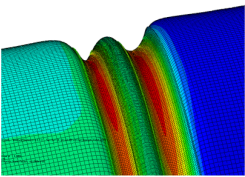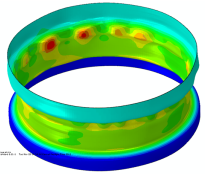Finite Element Analysis
Finite Element Analysis is a numerical simulation technique that evaluates the behavior of structures under various conditions such as mechanical and thermal loads. Using this technique, a challenging engineering problem that involves complex geometric details, nonlinear material properties, contact, and transient loads can be solved with high accuracy. The outcome of a finite element analysis may include stress distributions, displacements, reactions, contact pressure, mode shapes, natural frequencies, heat flux, etc.. A finite element model may be used for various purposes such as design verification, weight minimization, assessment of defects, and code compliance.
The accuracy of a finite element analysis is highly dependent on the characteristics of the model, such as analysis domain, material idealization, and selection of element types, shapes, and order. From an engineering standpoint, the most important factor in utilizing such models is the proper interpretation of results which requires practical experience as well as a profound understanding of the theory. At Houston Engineering Solutions, we have decades of industry experience and years of university teaching expertise that help us design models that are both accurate and efficient to solve the most challenging engineering problems
The accuracy of a finite element analysis is highly dependent on the characteristics of the model, such as analysis domain, material idealization, and selection of element types, shapes, and order. From an engineering standpoint, the most important factor in utilizing such models is the proper interpretation of results which requires practical experience as well as a profound understanding of the theory. At Houston Engineering Solutions, we have decades of industry experience and years of university teaching expertise that help us design models that are both accurate and efficient to solve the most challenging engineering problems








